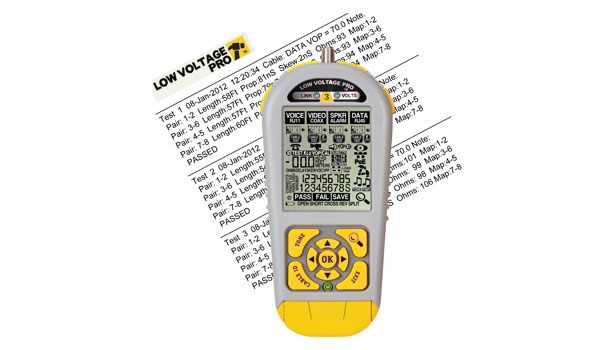Cable Testing Device Gets the Job Done




The older I get the more stuff I accumulate. And while the saying goes that “opposites attract,” it turns out that my lovely wife and I are both minor league pack rats who keep just about everything; anyone for a Motorola brick cell phone, circa 1989?
What compounds the issue is living in a small urban home. Whether it is equipment, books, toys, CDs, cassettes (yeah, I finally dumped the 8-tracks when I couldn’t find a functional player), devices and various possessions are stacked, boxed and jammed into our small attic and garage.
Which brings up our recent home refinancing effort. If you want to take advantage of today’s below 4 percent fixed interest rates, the lender is going to want everything from the past three years. So when searching for some obscure document (do they really have to survey the property again?) I trembled with joy and some sweat when said paperwork was finally located after a two-hour search of the attic.
A similar problem confronts security dealers when addressing an old or existing installation. With all of the new technologies available that can send network communications over existing cables, smart security dealers will use the wiring that’s already there, saving hours of installation time and cost. But often the cables are either completely unlabeled or the “electrical tape with a Bic pen written number” is so faded that it is unreadable.
Individual cable toners have been around for a long time and are simple and effective to use when identifying cables. However, unless there are two technicians working the job, a single tech is going to be on the Stairmaster pumping his or her way up, down and around the building trying to find the unknown cable(s) that is currently getting toned. All this checking can take valuable time and effort, adding to the potential of labor cost estimation overruns.
One manufacturer of testing equipment that is really in tune with alarm installation technicians’ needs is Byte Brothers, designers and builders of very practical, economical, and American-made testing devices. Their latest entry into their product line that can make your installations much easier is the “Low Voltage Pro,” a product set that provides detailed testing of coax, speaker wiring, phone lines, and UTP cables all in one handy package.
The tester comes in three models with available software upgrades to the basic device that can be downloaded into the tester. New features can be added without having to buy an entirely new testing device and carry it around on the job.
Let’s take a look at the basic Low Voltage Pro. This unit will test all cable types for delay, skew, continuity, and other important cable functionalities.
Cable identification can be handled easily by a single technician using the RJ-45/coax Wall Jack Mappers, which are purchased separately. Each “Mapper” is individually numbered, so it’s a simple matter to plug a number jack into a network outlet or coax connection, mark the numbers on a drawing, and then hook up the tester at the head end to each cable to be located. The tester will present the number of the “Mapper” that is connected to that cable — and now we know which wire is which.
Another feature of the Low Voltage Pro tester is a “speaker popper” that will put a “pop” sound onto attached speakers so that their cabling can be identified. In a similar vein this tester has a “port blink” output for RJ-45 connected UTP network cabling so that plugged-in cables can be differentiated on a network switch.
When the Low Voltage Pro is updated to the Model 2 version, a Time Domain Reflectometer (TDR) function is activated providing the exact lengths of various cables. This information is of particular importance when using coax or UTP to transmit both Ethernet and PoE power.
If you want the complete range of testing capabilities, the Model 3 Low Voltage Pro includes all of the functions listed above along with added features. This tester includes 10/100/1000 Ethernet detection on UTP ports, analog CCTV Vpp (peak-to-peak voltage), alarm loaded battery testing, and the ability to save up to 250 reports/tests for later conversion into printouts or digital storage.
Therefore, a single tester can pretty much identify and verify the quality of virtually every type of cable an alarm technician might encounter with the exception of fiber optics — all in one economical package. For more information talk to your local distributor or visit www.bytebrothers.com/lvpro to see videos explaining the functions and features of this innovative tester set.
In the meantime I will be searching high and low for some obscure item, such as the rusty old pliers stamped “Ford” that my grandfather used at the Ford dealership he worked at in the 1920s. It has to be here somewhere…
This article was previously published in the print magazine as "From Parts Unknown."
Looking for a reprint of this article?
From high-res PDFs to custom plaques, order your copy today!











